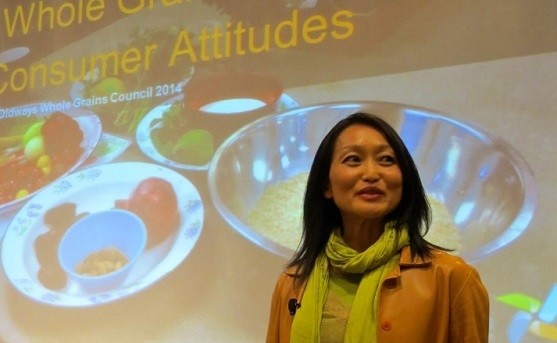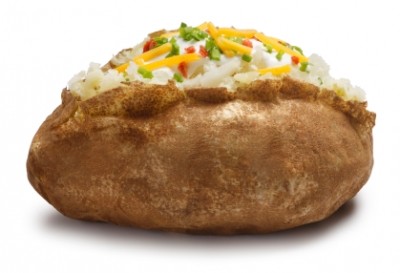Oldways Whole Grains Breaking Barriers Conference
Smartphone use among 5 key trends driving interest in healthy eating

“The smart phone has helped consumers increase their food literacy” by allowing them in a grocery store to quickly look up nutritional information about foods, identify healthier options and research how to prepare unfamiliar foods, said June Jo Lee, the vice president of strategic insights at the Hartman Group.
She noted that 82% of smart phone users believe the technology has improved how well they eat, and 44% use digital resources, such as blogs or Pinterest, to discover flavors, ingredients and cuisines.
In addition, social media platforms easily accessed on smart phones, like YouTube, “have replaced grandma or mom in terms of teaching people how to cook,” Lee said. This is empowering consumers to prepare new foods and buy healthy ingredients from a wide variety of cultures.
Other key drivers fueling consumer interest in healthy foods include an evolving demand for a higher quality eating experience that goes beyond sustenance, changes in when people eat, shifting demographics and the mainstream acceptance of wellness ideals, Lee explained at the Whole Grains Council’s Oldways Whole Grains Breaking Barriers Conference in Boston Nov. 9.
Higher quality is associated with healthier foods
As consumers try new foods and learn how to cook they are raising the bar for the quality of foods they buy, and they often equate higher quality with healthy, Lee said.
They are filling this demand “symbolically” by buying fresh, whole foods and whole grains that they perceive as more “real” than premade foods or refined grains, Lee said.
In her research, she found 42% of shoppers in the U.S. want foods made with “simple” ingredients and 46% want foods with better flavor, which they associate with freshness.
They also are turning to popular diets as a way to find recipes and foods they perceive as higher quality, Lee said. “Gluten-free, dairy-free, paleo – these are all ways that consumers are engaging with food and trying to customize food that is right for them.”
Millennials are leading this trend with 45% trying or adopting a special diet compared to 24% of boomers, Lee said. This is due partly to 29% of Millennials having food sensitivities compared to 16% of baby boomers. But adopting special diets also is Millennials “way of playing around and seeing what makes them feel good,” Lee said.
The thought of making healthy, customizable meals, however, can be overwhelming. More than half of shoppers do not want to spend time and energy thinking about cooking, so they are going to restaurants more, Lee said.
“Restaurants, not the home, are the nexus of quality,” Lee said. “Eating out is not a special occasion that you get dress up for anymore. It is just one of the options of how to get dinner done.”
The evolution of modern eating is driving revolution of healthy food
Other changes in modern eating, such as more frequent on-the-go eating, also is prompting the demand for more healthy but easy food options, Lee said. She explained under the old paradigm, on-the-go meant fast- or junk-food, which was acceptable occasionally but not for the frequency at which consumers now want quick meals.
On-the-go eating developed in part because consumers are busy and do not have time to plan, but also because “food is abundant and it is everywhere, so we don’t have to plan,” Lee said. For example, consumers often buy lunch at the grocery store, but will not bother to buy dinner at the same time because they do not know what they want.
In fact, 63% of consumers decide what to eat within an hour of eating – a statistic that climbs to 78% for Millennials, Lee said.
With such a high emphasis on speed, more than three-quarters of eating occasions involve a prepared or packaged food, Lee said. Again, she noted, this percentage rises to 88% for Millennials.
In addition, half of eating occasions are snacks, and of consumers who snack, 56% said their last snack was motivated by wanting something healthy, Lee said.
Health & wellness go mainstream
Consumer desire for healthy snacks and meals is influenced by the constant messages about wellness that bombard them, Lee said.
“That old idea that you are supposed to feel bad or bloated or have heartburn after you eat is not acceptable any more. Now consumers want foods that give them a lot of energy” and make them feel healthy, Lee said.
Most consumers see “our digestive track as the source of health and wellness,” so they want to maintain a healthy digestive system by avoiding foods that cause inflammation and eating foods that benefit the gut, Lee said.
For example, a third of consumers use food to prevent digestive disorders, which translates into a third now using probiotics to promote gut health compared to 24% in 2007, Lee said. In addition, 20% consumers are actively reducing gluten and 30% bought gluten-free products in the past three months because they believe gluten causes inflammation in the digestive system. They are also seeking out more whole grains and fiber to improve digestion, she said.
Shifting demographics influence food desires
Finally, Lee said, shifting demographics are exposing younger consumers to new flavors and diets and influencing their desire for healthy foods.
“Younger consumers are more diverse eaters than we were a generation ago and they want to try new global cuisines,” because they are exposed to more cultures now than previously, Lee said.
For example, 17% of the U.S. population is Hispanic, which will increase to 30% by 2050. In addition, since 1980 the percent of interracial marriages has climbed to 15% from 6.7% prompting families to blend their cuisine and expose children to more flavors and types of foods at a younger age.
As a result, more than half of Millennials tried new or global foods during their eating experience immediately prior to answering Lee’s questions, compared to only 39% of boomers, she said.
Going forward, food companies can tap into these sub-trends by meeting with consumers where they are online, engaging with them in ways that make healthy fun and also by showing them how to create affordable, higher quality foods that is accessible and sustainable, Lee concluded.















